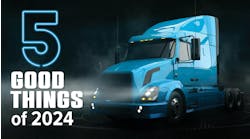NASHVILLE, TN. General Motors is pushing for wider use of ethanol-gasoline blended fuels to help the U.S. reduce oil imports and drive up sales of its ever-widening line of vehicles capable of running on ethanol blends.
“Take Brazil. About seven to eight years ago it legislated the wider use of what we call E85 -- an 85% ethanol and 15% gasoline blended fuel – and now they are completely oil-independent as a country,” said Brian McVeigh, gm of the OEM’s Fleet and Commercial unit. “They’ve done it; proved it’s doable.”
Speaking here as part of a ride and drive event to highlight several 2007 GM models – notably its “flex fuel” lineup of trucks and cars capable of running on both E85 and pure gasoline – McVeigh said the main advantage ethanol offers is its simplicity. It’s a fuel that can be easily distributed using current gas station infrastructure, doesn’t affect vehicle power or performance characteristics, and helps reduce greenhouse gases as well, he added.
“The investment in E85 is miniscule compared to fuel cells, for example,” McVeigh said. “And ethanol doesn’t have to be made from just corn. It can be made from other foodstuffs such as beats and, though more complicated, switch grass. If we are able to make it from non-cultivated organic sources, like switch grass, that would drop the price point because we would not be competing on the global food market for raw materials.”
Ed Peper, gm of the Chevrolet division, noted that Chevy is adding the Avalanche sport utility vehicle (SUV)-pickup combination and Tahoe SUV to its flex-fuel vehicle lineup in 2007. The plan is to have 3.5 million E85-compatible vehicles on the road by 2010. “You’re going to hear a lot about E85 from us because we believe it’s a good alternative fuel option,” he said.
Ross Hendrix, director of marketing for Fleet and Commercial, noted that commercial customers are showing strong interest in acquiring E85-capable medium-duty trucks. “We’re moving on that front real quick,” Hendrix said. “E85 is being used across our product line, from cars to light trucks, and we hope to include medium-duty trucks as well.”
E85’s success, noted McVeigh, will hinge on what happens to crude oil prices in the near future. “If oil goes back down to say $50 or $40 a barrel, then no, E85 doesn’t make financial sense,” he said. “But it if stays up around $70 a barrel and gasoline costs stay around $3 a gallon, that’s a very different story. The simple answer is that if the price of oil stays high, then E85 is viable.”


